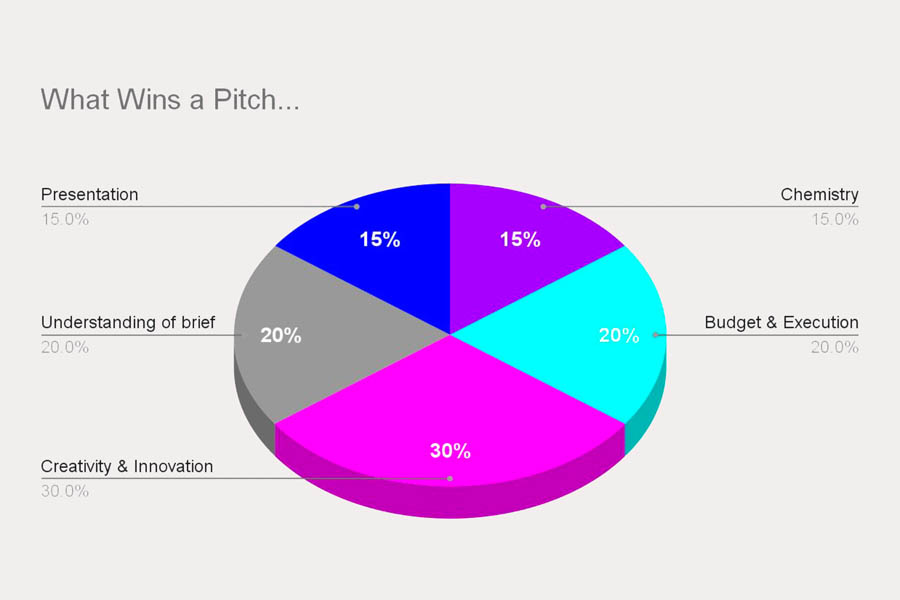Want to win 80% of your pitches?
Experience designer and creative strategist Nancy Duncan wins 80% of hers, having secured work for Meta, Google, Diageo, Samsung, Diageo, Adidas, and Porsche, among many other big hitters.
Pitching for work can often feel like a chaotic and ambiguous process. Not only can it be stressful for the pitch team, it’s often also quite boring for those being pitched to. Many agencies fail to truly answer the brief or think about the experience – a particular crime in the experience world!
But when it comes to how to win pitches and influence people, Duncan brings structure, order and a dash of magic to the process. She specialises in pitching within the brand experience world and the wider Experience Economy.
In this Campfire – a repeat of her hugely in-demand session from the 2024 World Experiences Summit – she shares the secrets of her approach, which will not only help you win more often and make more money, but also transform pitching from an ordeal into an enjoyable opportunity to get closer to a brand.
You’ll learn just how important team chemistry, budget and execution, understanding the brief, creativity and innovation, and the presentation itself are when it comes to crafting a winning pitch, and leave excited for your next pitch rather than dreading it.
Say No To The Wrong Pitches

“The difference between successful people and really successful people is that really successful people say NO to almost everything.” Warren Buffett
Many agencies die within a couple of years – not necessarily because their ideas are bad, but because they pitch themselves to death. Before you do anything else, Duncan points out that first you need to have a process to qualify your pitches and decide if you have a chance of winning.
“Pitches cost time, money, and energy, and it’s really demoralising to lose. If you don’t have the credentials to back up your pitch, you need to decline with dignity.” Nancy Duncan
Having a “pitch scorecard” to help you work out whether to accept, reject or re-evaluate a pitch opportunity can help steer this process. You might want to ask yourself the following questions geared towards making this decision:
- Competitive Landscape: how many other agencies are pitching, and who are they? Is the incumbent included? Will the client allow a face-to-face or telephone briefing?
- Client & Relationship: how strong is the client relationship? Is there potential for long-term growth? What’s their reputation? Are you passionate about the work?
- Budget: what’s the estimated income? Is the budget realistic for the scope of work?
- Opportunity Budget: what’s the estimated cost of the opportunity – both internal staff costs, and external costs like freelancers and expenses?
- Response Delivery: do you have the appropriate skill set in house? Is there enough time to deliver a decent response? What will win it – the creative, price, or innovation?
If your overall score is over 70%, you might want to proceed. Duncan throws out around 50% of pitch opportunities based on this exercise.
If you ignore this stage, you risk regretting it! Duncan recalls being brought in late for a big pitch where $80k was being spent, a large team with the wrong people had already been assembled, and no-one had a relationship with the client.
Rather than sticking with her gut, she proceeded and had a horrible experience culminating in losing the pitch – and the client later affirmed her early doubts by revealing that they would never have won the work as they didn’t have a relationship.
The Top 5 Factors In Winning A Pitch

Once you’ve qualified your pitch, Duncan has identified 5 factors that contribute towards your likelihood of success, along with how important they are:
- Chemistry (15%)
- Budget & Execution (20%)
- Creativity & Innovation (30%)
- Understanding of brief (20%)
- Presentation (15%)
1. Chemistry (15%): Why Pitching Is Like Dating

“Great things in business are never done by one person. They’re done by a team of people.” Steve Jobs
It’s no secret that people crave connection, and that we often make decisions emotionally rather than rationally. The same goes for pitching: you need good chemistry not only with your client, but also within the team putting the pitch together.
The best pitch teams thrive on structure, clarity, and a lack of ego in the room. You can have both too many or too little people – Duncan recommends 3-6 depending on the size of the pitch, and to include the following roles:
- The Pitch Parent / Account Lead: responsible for making sure the brief is being answered and that the team stays on track.
- The Thinker / Strategist: responsible for understanding the brand and going beyond the brief.
- The Visionary / Creative: responsible for the mad ideas and innovation that will impress.
- The Engineer / Producer: responsible for making it all a reality.
Your pitch needs to be run like a project, with daily stand-ups and clear roles and responsibilities. It’s a full-time project, not something to be squeezed on the side.
And when it comes to the client, it’s a bit like dating: you can have the most amazing profile, but you won’t get a date without good chemistry. The client will always be assessing you, before, during and after the pitch, so keep in mind: how am I going to make them look good? Make their life easy and straightforward? What will make them want to work with me?
2. Budget & Execution (20%): Building Trust & Certainty
“The enemy of art is the absence of limitations.” Orson Welles
First off, you need to consider what percentage of the opportunity value you’re going to invest in your pitch – something that often goes overlooked. Your time is valuable, so the time you spend on it should be equated to cost.
Duncan recommends a 3% investment, although this is flexible depending on the pitch – you might want to invest a higher percentage for a smaller pitch and vice versa.
And no matter how wonderful your ideas, if you ignore the client budget you’re not answering the brief. A budget breakdown gives certainty and structure to each department, so they all know exactly what part of the budget they have to work with. An example budget breakdown might be:
- Agency fees (staff and pitch costs): 30%
- Creative (content, entertainment): 20%
- Production (environment, technical production): 20%
- Logistics (venue hire, staffing): 20%
- Miscellaneous (contingency, digital production, photography): 10%
These figures are just illustrative, as your budget allocation percentages will depend on the brief. The more you do this exercise, the more accurate you’ll get – and the more you’ll get a reputation as a trusted partner who says what they’re going to do and executes it.
3. Creativity & Innovation (30%): Bringing Form To The Fun Part
“When forced to work within a strict framework, the imagination is taxed to its utmost—and will produce its richest ideas. Given total freedom, the work is likely to sprawl.” TS Eliot
This is often where 90% of the effort goes, and there’s a perception that you can’t be creative within a structure. However, in pitching you need a framework, and having a flexible process that everyone understands can not only support creativity, but make the whole thing more enjoyable.
Duncan recommends running your pitch as a live project with a timeline. This might look similar to the below:

At the planning and strategy stage, you should be working out what will win the pitch, the team and your budget. If the client won’t tell you the budget, that’s a red flag – you can always ask for “bronze, silver and gold” budget estimates as an indicator.
Between this and the creativity & innovation stage, you should ask for a client Q&A. This isn’t a place to go over the brief, but to ask smart questions that go beyond it and show you’re thinking about more than they’ve sent over.
And as part of the research phase, don’t just get stuck with desk research – think like an experience designer and take your team to experience the brand, perhaps by going to their store if they’re a luxury retailer.
Duncan strongly recommends asking for a “tissue meeting” between this and the storytelling phase. This is a midpoint check-in with the client where you show your early ideas and allow them to make suggestions, building a collaborative relationship and making sure you’re on the right track.
In the final phases, you work out your “pitch magic” (more on this later) and visuals, before finalising the budget, rehearsing, presenting and (hopefully) winning.
A note on getting investment for your innovations: you might worry that if you follow the brief to the letter you’ll produce something boring, but if you’re too imaginative you’ll scare the client off.
Duncan suggests researching statistics and case studies that can back up your ideas – and if you’ve executed a similar project beforehand (or know someone who has), taking the client to experience it for themselves.
4. Understanding The Brief (20%): Find Your Beacon Question
“When people talk, listen completely. Most people never listen.” Ernest Hemingway
An RFP brief can run to dozens or even hundreds of pages. If you can distil them to a simple question that gives to a better understanding of what the client really wants, this can become your beacon for the entire team. For example, Duncan was able to reduce a 60-page RFP to one key challenge: “how might we make the use of AI less threatening to our customers through an interactive experience?”
Another crucial part of understanding the brief is understanding the audience. 90% of agencies don’t always do this persona mapping, especially in the experience world, so it can really give a competitive advantage.
To do this, you need to work out your audience’s:
- Goals: what are their overall goals? What are their goals for attending the experience?
- Needs: what are their personal needs? How can the experience answer their needs?
- Attitudes: what are their current attitudes? Do you need to change these? What do they currently think, feel and do?
- Pain points: what are their pain points? What about in the context of the experience?
- Cultural context: what’s the wider cultural context, e.g. the cost of living? How will this affect the experience, and how can we be mindful of it?
5. Presentation (15%): Bring The Magic
“I’ve learned that people will forget what you said, people will forget what you did, but people will never forget how you made them feel.” Maya Angelou
There are three key elements that make a pitch look good: creativity, storytelling, and magic. When it comes to structuring your presentation, Duncan suggests the following:

- A strong opener. You’ll often find yourself waiting for 5-10 minutes at the beginning of a pitch before everyone arrives. Usually, this time is spent with the static opening slide of your presentation up on the screen – but this is a waste of time and retail space. Instead, create something dynamic: an animation, or punchy questions to get the clients excited and thinking before you even start.
- The strategy. Tell them what you’re pitching for and show your unique point of view.
- The idea. This is your elevator pitch, and should be expressed clearly and concisely, without any jargon.
- Feasibility. You might not lead with this, but make sure there are people in the room who can answer any tricky questions.
- A strong closer. Always end with a call to action that will leave a lasting impression.
On top of all of this sits your “pitch theatre”: the magic that will make you stand out. Often, a pitch takes the form of a standard presentation, when (particularly in the experience industry), it needs to be an experience in itself.
You could use a mood film to convey your creative idea rather than a series of slides. Bring a VR headset to showcase the scope of your virtual world. Or do a beta sensory experience invoking taste or smell.
If you can turn the pitch into an interactive experience, even better. Ogilvy’s Rory Sutherland once famously staged a pitch about customer experience where he decided to turn the agency into an example of a terrible customer experience.
When the clients arrived they were confronted with uncomfortable chairs, a rude receptionist, lukewarm coffee, and a long wait. He then told them that this was how their customer experience currently felt – and how they could fix it. (For more on unconventional ideas using behavioural science, see Sutherland’s Campfire Who Wants To Be An Experience Alchemist?)
This is especially relevant when pitching to an investor. If you can give them a taste of the experience they’re potentially investing in – either by inviting them to it or taking a version of it to them – you’ll increase your chances of them buying the vision.
But What If You Lose The Pitch?
Even if you follow all of the above, sometimes you’re still likely to lose the pitch – even Duncan loses 20% of hers. But even this can be turned into an opportunity.
Always ask for a debrief to find out where you went wrong and learn from it. And if you want to pitch for another project with the same client, use it as an opportunity to show that you’ve listened and learned from their feedback.
Use persona mapping to understand clients, their goals and pain points, and improve your pitch based on it. Spend a good amount of time – half to one day – thinking of smart questions for the client Q&A. And be sure to request a tissue meeting at the midpoint, ideally staged somewhere more engaging than the office.
The WXO Take-Out
Whether you’re pitching for a multimillion-dollar project or a smaller piece of work, Duncan’s priceless pitch advice underscores the importance of adding structure and process to corral your creative ideas, unify your team, and align with the client and the brief at all stages.
So next time you’re pitching for an experience, ask yourself:
- Have you assessed whether or not to pursue the pitch?
- Do you have a pitch process?
- How can you ensure you understand the client’s brief?
- How can you use pitch theatre to create a memorable and engaging presentation?
Want to come to live Campfires and join fellow expert experience creators from 39+ different countries as we lead the Experience Revolution forward? Find out how to join us here.





